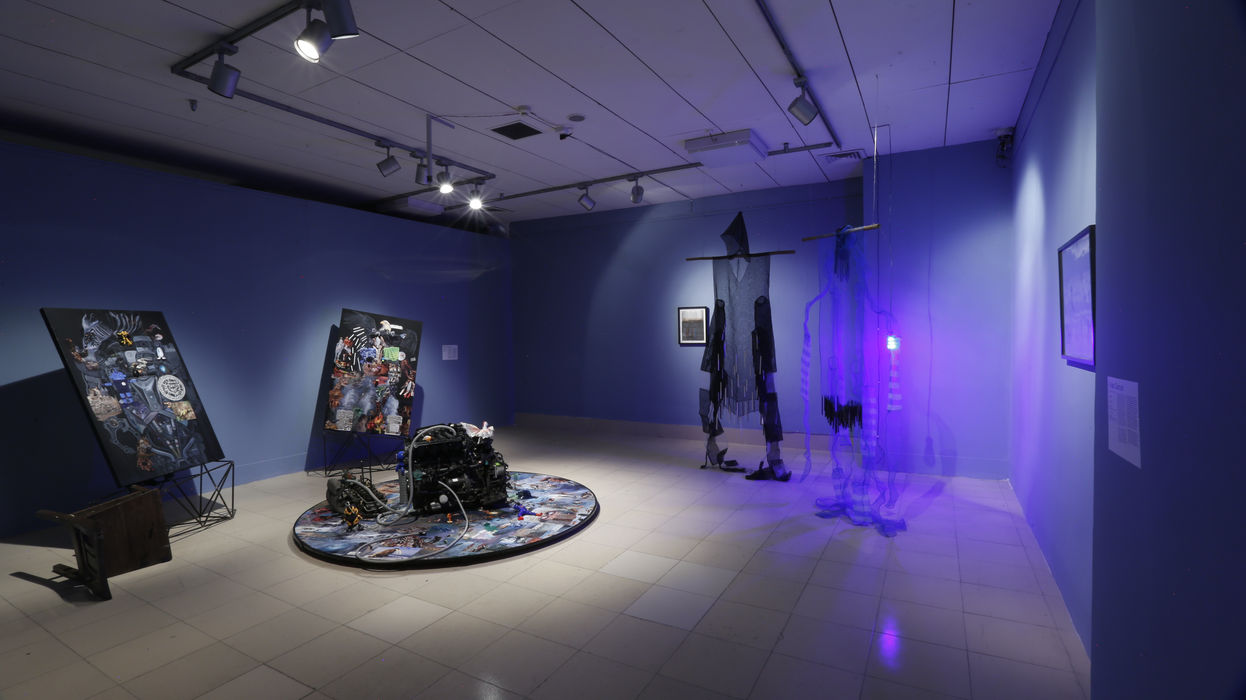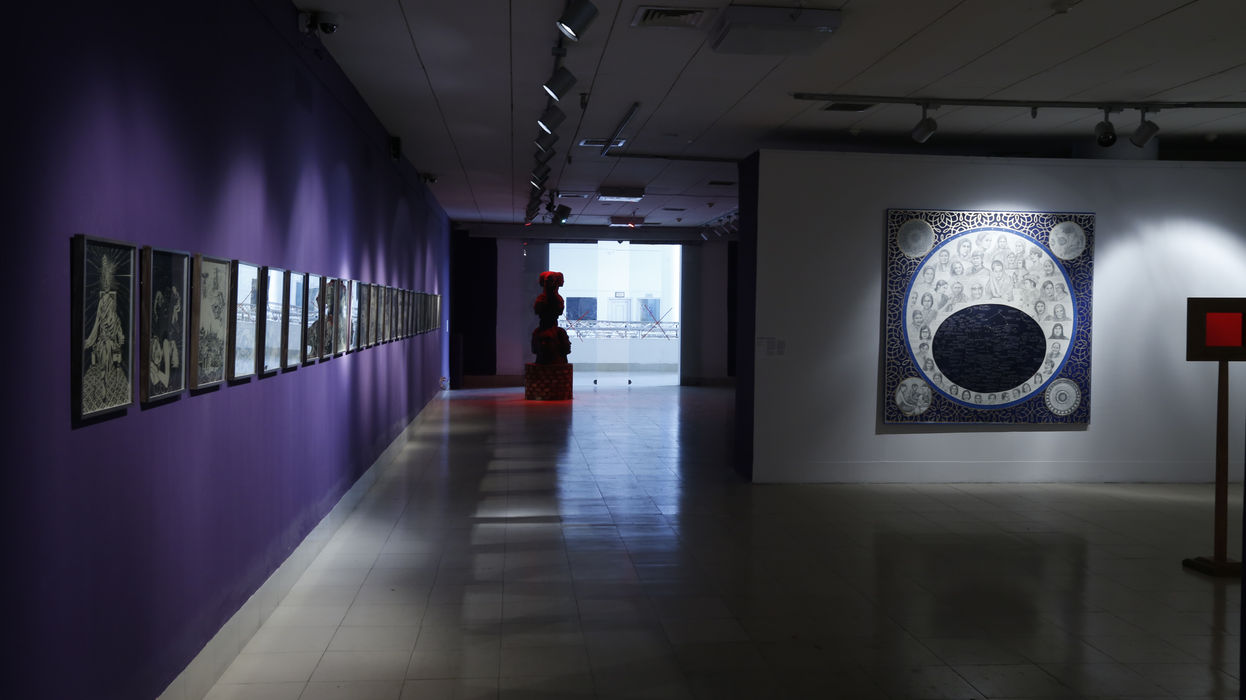What does an enfranchised future look like? Since the inception of the nation-state, not everyone has been considered a citizen with rights to protect. Throughout the world, the disenfranchised including peoples of colour, indigenous peoples, and people of diverse sexual and gender orientation, continue to fight for spaces to endure, imagining how and when their security, their representation in and of the world is recognised. The artists in this movement employ fantasy and poetry to imagine territories that emancipate them from the everyday violence of capitalism, patriarchy, and political/religious fundamentalism. These worlds might exist in outer space, on the ocean floor, at the poles of the planet, or they may emerge from hiding places between the lines that seemingly restrict and foreclose uncertain histories.
Adriana Bustos
b. 1965, Córdoba; lives and works in Buenos Aires
Venus Planisphere 2, 2019–2020
Acrylic, Graphite, and Silver Leaf on Canvas
Commissioned for DAS 2020
Courtesy of the artist
Official Territory, 2019
Acrylic, Graphite, and Silver Leaf on Canvas
Courtesy of the artist and Collection Sharjah Art Foundation
Adriana Bustos’s Vision Machine project poses questions about what we see, how we see it, and how vision can reinforce or dismantle the narratives which underlie systems of oppression. Two large maps – representing polarised views yet identical in structure – depict the constellations as they appeared in the skies on day one of month one of the Christian era. The names of stars have been replaced by words and concepts which act as a guide to the drawings around them. One of the maps quotes historical images depicting acts of patriarchal violence. They are rendered in red, and when seen through a filter positioned in front of the work they fade away and our gaze is instead drawn to the images in the opposite map depicting known and unknown heroines as well as references to repressed practices and events associated with women. This commission for DAS extends the artist’s research into the feminist histories of South Asia.
Bustos works with photography, video, performance, and drawing, addressing concepts drawn from anthropology, history, science, popular culture, fiction, biographical writings, and academic and intuitive knowledge. Her works act as arenas of intersecting methodological and representational systems that challenge global histories, specifically concerning Latin America.
Bharti Kher
b. 1969, London; lives and works in New Delhi
Intermediaries, 2019–2020
Commissioned and produced by Samdani Art Foundation for DAS 2020
Courtesy of the artist, Samdani Art Foundation, and Nature Morte. Realised with additional support from Nature Morte and Perrotin
Bharti Kher’s Intermediaries series invites us to consider a transitional space in the present – somewhere between truth and reality. This notion of the go-between or medium fascinates Kher, often resulting in unlikely pairings becoming hybrids, often half-female forms such as these women in the process of becoming snakes in this newly commissioned project for DAS. Made by traditional idol makers, Kher’s painted mud and clay sculpture rises from the earth and will return to it through the natural process of entropy, speaking to the many layers of religions and cultures that have existed on the land that is now Bangladesh. Her work reminds us that there are multiple selves within us and that we are in a constant state of transformation.
Kher’s way of working is radically heterogeneous, encompassing painting, sculpture, text, and installation. Central themes are the notion of the self as formed by multiple and interlocking relationships with human and animal bodies, places, and readymade objects. The body, a central element to her work, is one of the many tools she uses to transform metaphysical narratives into forms of hybridity.
Chitra Ganesh
b. 1975, Brooklyn, New York; lives and works in Brooklyn
Sultana’s Dream, 2018
Portfolio of 27 Linocuts BFK Rives Tan
Courtesy of the artist and Samdani Art Foundation
Manuscript, 2018/2020
Bamboo, raw silk, video
Projection developed with and animated by The Studio NYC
Courtesy of the artist
Totem, 2018/2020
Brick, bamboo, clay, mud, and straw
Commissioned and Produced by Samdani Art Foundation for DAS 2020. Courtesy of the artist and Samdani Art Foundation
How we do, 2018/2020
Video, chalk, paint, jute structure
Commissioned and Produced by Samdani Art Foundation for DAS 2020. Courtesy of the artist and Samdani Art Foundation
Using printmaking, video, installation, and sculpture, Chitra Ganesh unpacks gender and power in a futurist imaginary inspired by the utopian, feminist, sci-fi novella Sultana’s Dream (1905) by Bengali author and social reformer Begum Rokeya Sakhawat Hossain. In the words of the artist, the project ‘draws on Hossain’s vibrant imagery, translating a story written in verse into a visual grammar that connects with problems that shape 21st-century life: apocalyptic environmental disaster, the disturbing persistence of gender-based inequality, the power of the wealthy few against the economic struggles of the majority, and ongoing geopolitical conflicts that cause widespread death and suffering. These works comment on this fraught moment in world history, demonstrating the enduring relevance of feminist utopian imaginaries in offering an invaluable means of envisioning a more just world.’ Ganesh met with Bangladeshi artisans and architects as well as members of the broader queer and trans community of Dhaka in the process of creating this commission for DAS. Their open process of sharing know-how challenges received notions of how labour is gendered and organised within patriarchal structures.
Ganesh works across media including drawing, installation, animation, and prints. Her work draws from and deconstructs historical and mythological texts to queer the future of the iconic female figure. Her pictorial language is inspired by surrealism, expressionism, and South Asian visual culture, such as Kalighat painting and ACK comics.
Edgar Cleijne and Ellen Gallagher
b. 1965, Eindhoven; lives and works in Rotterdam and New York. b. 1965, Providence, Rhode Island; lives and works in New York and Rotterdam
Osedax, 2010
16 mm film projection, Hand-painted slide projection, Music: ‘Message From A Black Man’ by
The Whatnauts, 1970 (A&I Records).
Courtesy of the artists and Gagosian Gallery. Presented with the generous support of Gagosian
Gallery and the Embassy of the Netherlands in Bangladesh
The collaborative film installation Osedax is named after a new species of bone-devouring worm discovered around the time this work was made. The discovery inspired Edgar Cleijne and Ellen Gallagher to draw parallels between science fiction and hard science protocols, focusing on transformation processes of physical matter where you think you see one thing, but it turns out to be completely different. The work is based on ‘whale fall,’ the scientific term for dead whales that have fallen to the ocean floor and are consumed by scavengers. The work relies on antique film technology (16 mm and synced slide projectors), but the artists also use modern 3D animation technology to draw into the film, weaving between watery passages and creating a portal into enchanting worlds populated with micro-organisms and submarine life forms and mythical stories of the African diaspora.
Edgar Cleijne is a Dutch artist predominantly working in photography and film. Merging discordant threads of analogue and digital imaging and sound, Cleijne looks at the effects of the human-engendered climate emergency in the crossing points of culture and nature. Gallagher’s work comprises painting, film, cut and layered paper, and intricate combinations of the three. Through processes of accretion, erasure, extraction, and synthesis, she counters static representations of race and nation, traversing geographies and histories. The eclipse of the African body into American blackface minstrelsy informs Gallagher’s investigations into the violence embedded within the history of abstraction.

Ellen Gallagher
b. 1965, Providence, Rhode Island; lives and works in New York and Rotterdam
Watery Ecstatic (RA 18h 35m 37.73s D37° 22’ 31.12’), 2017
Cut Paper
Courtesy of the artist and Samdani Art Foundation
Ellen Gallagher’s Water Ecstatic series (2001 onwards) imagines life as fluid: from our early days as cells that develop into foetuses within amniotic sacs in our pregnant mothers to the imaginary underwater world of Drexciya. In this myth, created by a Detroit-based electronic band of the same name, children born from pregnant African slaves thrown overboard during their passage across the Atlantic Ocean have gills and webbed feet and are therefore able to thrive underwater without the need to come up for air in the oppressive racist world above. Drexciya’s world started out on the ocean floor and sailed into the cosmos when the group bought the naming rights to a Drexciya star, whose celestial address is referenced in the title of this work. Gallagher relates her labour-intensive cut-paper process on bright white paper to scrimshaw (illustrative carvings primarily made on whalebones and ivory). The intricate forms that she carves into paper of botanical and marine life growing from African masks conjure a utopian realm, adjacent to a horrific one, that can only exist in the realm of fantasy.
Gallagher’s work comprises painting, film, cut and layered paper, and intricate combinations of the three. Through processes of accretion, erasure, extraction, and synthesis, she counters static representations of race and nation, traversing geographies and histories. The eclipse of the African body into American blackface minstrelsy informs Gallagher’s investigations into the violence embedded within the history of abstraction.
Héctor Zamora
b. 1974, Mexico City; lives and works in Lisbon
Movimientos Emisores de Existencia (Existence-emitting Movements), 2019–2020
Performative action with women and terracotta vessels, HD Video 5:25 min
Courtesy of the artist and Labor
Movimientos Emisores de Existencia (Existence-emitting Movements) is an action in which a group of women walk directly on an installation comprised of hundreds of raw clay vessels in different shapes and sizes inspired by traditional ceramic traditions of Bangladesh. Most cultures, including those of the artist’s native Mexico as well as Bangladesh, perpetuate the iconic image of a woman bearing a vessel on her head to transport water or food; a symbol of the hard domestic labour weighing down women in society. Héctor Zamora disrupts the order of things by placing the vessel not upon the women’s heads, but rather beneath their feet. By inverting the equation, what occurs is a shared space of liberation where women can turn the tide of patriarchy and recover pleasure in their lives.
Zamora uses materials that resonate with the location of his chosen site, such as terracotta and bricks that allow him to question and engage with institutional structures. He often operates in dialogue with local communities, which allows him to produce ephemeral site-specific works that highlight social, political, and historical issues specific to their context.
Himali Singh Soin
b. 1987, New Delhi; lives and works between London and New Delhi
we are opposite like that, 2018–2020
Two-channel video installation, 11:35 min
Courtesy of the artist. With support from India Foundation for the Arts, Frieze London, Forma Arts and Media Ltd., and Channel 4 Random Acts
we are opposite like that is a magic-realist tale from the high Arctic circle, told from the nonhuman perspective of an elder that has witnessed deep time: the ice. Shown in an installation format for the first time, Himali Singh Soin’s videos recount the 19th-century anxiety of an imminent ice age and illumine the hubris of the abandoned township of Ny London, where British extractionists mined marble that turned to dust when the permafrost evaporated. An alien figure, part-cyborg, part-vessel of ancient feminine knowledge, explores the blank, oblivious whiteness, foraging for decolonial possibilities in a landscape of receding glaciers. Inspired by field recordings, an original score for a string quartet creates an etheric soundscape coded with temperature variances and latitudes and longitudes from the field. ‘we are opposite like that’ beckons the ghosts hidden in landscapes and turns them into echoes, listening in on the resonances of potential futures.
Soin works across text, performance, and moving image. She utilises metaphors from the natural environment to construct speculative cosmologies that reveal nonlinear entanglements between human and nonhuman life. Her poetic methodology seeks inspiration from the ancient Stoics and contemporary philosophy to explore alchemical ways of knowing and the loss inherent in language.
Huma Bhabha
b. 1962, Karachi; lives and works in Poughkeepsie
Cowboys and Angels, 2018
Cork, styrofoam, acrylic paint, oil stick
Courtesy of the artist and Samdani Art Foundation
Untitled, 2014
Ink and collage on colour photograph
Courtesy of the artist and Samdani Art Foundation
Intense in their presence, Huma Bhabha’s works aggressively attract the viewer by layering visual textures from across the many landscapes (real and imagined) that she has inhabited, from rural New York to Karachi to cinemas projecting horror and science fiction movies. She found in her research that illustrators of sci-fi movies and comic books used African masks and imagery from other cultures to develop their characters. According to the artist, the issues that sci-fi deals with – such as the state of the world, the future, and the fate of human beings – closely parallel her own interests as she explores the global as local and globalisation as the new colonialism. She sees these themes as ‘eternal because as human beings we haven’t been able to get beyond them.’ Bhabha’s alien forms emerging from photographic paper, cork, and styrofoam suggest a world beyond our human limitations.
Bhabha’s work addresses themes of colonialism, war, displacement, and memories of home. Using found materials such as styrofoam, clay, construction scraps, and cork, she creates haunting human figures that hover between abstraction and figuration, and include references to science fiction, horror films, tribal art, religious reliquary, and modernist sculpture.
Marzia Farhana
b. 1985, Dhaka; lives and works in Dhaka
Sovereignty to Nature, 2019–2020
Acrylic painting & collage on canvas, toys, magazine images, texts, installations with domestic materials, bricks, small engines, everyday objects, chair/tool, found footage, video on CRT monitor/3D projector
Commissioned and Produced by Samdani Art Foundation for DAS 2020. Courtesy of the artist and Samdani Art Foundation
We live in a man-made world; the discrimination against women and nature on this planet is a part of the machinery behind its violent destruction. Marzia Farhana’s DAS commission Sovereignty to Nature addresses this discrimination from an eco-feminist perspective. Situating her subject matter in Bangladesh, a nation among the world’s most heavily affected by environmental destruction, with less than five per cent of its forest cover remaining, Farhana traces the current situation to the male invention of capitalism that subjugates nature to a rational economic calculus. Divided into three individual paintings signifying collapsed bodies in an apocalyptic world, elements such as machinery parts, toys, everyday ordinary materials, domestic materials and printed images tell the story of the destruction of nature and the consequential suffering of women and the planet. Farhana invites the viewer to call for a radical restructuring of human sovereignty, where all living and non-living inhabitants of our planet are included.
Farhana works with several media including painting, installation, and video. Her practice is time-and-space based, facilitating collaborations, participation and reinforcing the possibility of co-authorship on works of art that reinvent empathy. Farhana has recently co-authored works with a government school in Bangladesh, as well as with local communities in Kochi. For her, art is an ‘act of resistance’ to overcome the violence committed by the domain of the hegemonic society.
Nilima Sheikh
b. 1945, New Delhi; lives and works in Baroda
Beyond Loss, 2019–20
Casein tempera on canvas scroll
Commissioned for DAS 2020. Courtesy of the artist and Chemould Prescott Road. Realised with additional support from Chemould Prescott Road
‘Immediate trauma finds historic/mythic prototypes. Dire times call for apocalyptic vocabularies,’ reflects Nilima Sheikh on the tragedies long-plaguing Kashmir, the epicentre of the destruction left in the wake of the British partition of India and exacerbated by rising Indian nationalism. The work takes the form of a narrative scroll that immerses the viewer in its representation of mourning, loss, and absence. As in life, song, and performance, so too in painting we look for a form to express and release what can seem inexpressible. In many cultures of mourning, women participate in prime roles, however, there are times when mourning has to be conducted in silence, in solitude, in the incantations of memory. Sheikh has been visiting Kashmir since she was a young child and has made work about the plural history of the place since 2002. This new work signals the valour of the women of Kashmir, whose energies are necessary to metaphorically ignite the flame of the cooking pot to reignite home-life in the face of an oppressive world outside.
Sheikh works with paper, painting, installation, and large-scale scrolls. Drawing from her extensive research on traditional Indian and Asian art forms, including mural paintings from China and screens and scrolls from Japan, her work reflects her decades-long advocacy for women’s rights. Sheikh’s mystical landscapes address themes such as displacement, longing, historical lineage, violence, and ideas of femininity.
Sara Sejin Chang
(Sara van der Heide)
b. 1977, Busan; lives and works in Amsterdam and Brussels
The Mother Mountain Institute, 2017–ongoing
Installation, collection of stories, sound, drawings
Commissioned and Produced by Samdani Art Foundation for DAS 2020. Courtesy of the artist. Realised with additional support from Mondriaan Fonds and the Embassy of the Netherlands in Bangladesh
With special thanks: Mrs Sayrun; Dutch Foundation Shapla Community
Voice mother: Mehreen Mahmud. Voice mountain: Moktadir Dewan. Words mountain written by:
Sara Sejin Chang (Sara van der Heide); Agnieszka Polska, Kumgang Sunimthe head monk of the Seon Monastry of Mihwangsa, South Korea; Park, Jin Yeo, the woman who can see the future and the past, South Korea; Jeonhwan Cho;Dario Escobar, hermit Qadisha Valley, Lebanon; Nabil Rahman
The Mother Mountain Institute aims to give a voice to mothers who have, often under duress, given their child up for adoption. Legacies of imperialism and colonialism can be read through the lens of transracial and transnational adoptions with the Global North. The interests of the birth mother are often overlooked with its many stakeholders. Women in precarious social and economic conditions can be faced with pressure from the state, the church, and/or criminal traffickers. In this work, two figures are evoked: the Mother and the Mountain, who both speak. A woman’s voice narrates the story, based upon an interview with a mother by the artist that took place in January 2020 in Bangladesh. Alternating, the mountain speaks. After separation, the respective desires of the mother and child to find one another again remain. Like celestial bodies pulled by gravity, they circle around each other. Besides the political, economic, cultural and historical context provided about the why, the how and the when, no sufficient answers are provided that can heal the inner wound of being separated from one’s child. The mountain is present here as a patient shelter and as a spiritual entity who might provide answers to impossible questions transcending rational thought, represented through sound and drawings made during the artist’s walks in hills and mountains known for their spiritual qualities in Poland, India, Bangladesh, Lebanon, and South Korea.
www.mothermountaininstitute.org
Sara Sejin Chang works with drawings, installations, performances, films, and interventions, examining patriarchal and Western imperialist ideas about linearity, gender, nation-state, spirituality, and world-making. In many of her works, Chang draws from her historiography and reflects paradoxically on these artistic processes and interventions as acts of historical repair, healing, and belonging.
Saskia Pintelon
b. 1945, Kortrijk; lives and works in Mirissa
No News Good News, 2019
Collage on Newspaper
Courtesy of the artist and Saskia Fernando Gallery
No News Good News is an ongoing body of work where the artist Saskia Pintelon imagines a world where the text comprising the English, Flemish, and Sinhalese newspapers that she reads is rearranged to tell stories of more hopeful and equal futures. With a subtle sense of humour, these subversive works push back against patriarchy in the world which often defines what is newsworthy, proposing new rules to break rigid standards of beauty and definitions of success and happiness. They question reigning paradigms about a variety of subjects from old age, to romance, matrimony, gender, religion, addictions through association and juxtaposition. The strong visual quality of Pintelon’s newspapers forces us to stop and reflect, and through her imaginative editing process we are able to consider news that we overlook as a result of information overflow.
Saskia Pintelon is at heart a figurative painter who periodically verges towards abstraction and text-based work. Inspired by local and universal issues, stories from the gut and the heart, politics and day-to-day concerns, her body of work interprets the collective human experience, environment and the cycle of life with intimate and personal preoccupations. She has spent nearly four decades working in Sri Lanka and her work reflects the hybridity of living between and across cultures.
Taslima Akhter
b. 1974, Dhaka; lives and works in Dhaka
Stitching Together: Garment Workers in Solidarity, 2017
With Bangladesh Garment Sromik Samhoti (Bangladesh Garment Workers Solidarity)
Community Stitching Action on Cloth Made by families of Bangladeshi Garment Workers. Courtesy of the artist
‘A thousand stars twinkle on the sky, and I dream of Beauty by my side,’ reads the translation of a traditional Kantha-stitched statement embroidered into Taslima Akhter’s moving ‘Memorial Quilts’. This is not an abstract dream, Beauty was the wife of Alam Matobor who disappeared in the deadly collapse of the garment factory Rana Plaza in 2013, one of the worst industrial accidents in history. Their daughter Farzana embroidered her father’s words on a handkerchief, and the stories of loss of 14 other families make up the details (which include messages, photographs, and belongings donated by surviving relatives) comprising this powerful collaborative reminder to ‘remember the dead and fight for the living.’ A counter-narrative to disaster, these quilts empower families to memorialise their loved ones and draw together a growing number of allies who demand the wage and safety conditions necessary to avoid history repeating itself.
Akther is a documentary photographer and human rights activist, drawing attention to the issues faced by garment workers for over a decade. Her photographs address issues of gender, the environment, and social discrimination. Akther’s politics strongly influence her photography, which often captures the lives and struggles of those she rallies for. She is the chair of Bangladesh Garment Sromik Samhoti (Bangladesh Garment Workers Solidarity) founded in 2008.
Vivian Caccuri
b. 1986, São Paulo; lives and works in Rio de Janeiro
A Soul Transplant, 2019
Drawing on paper
A Sweet Encounter, 2019
Drawing on paper
New Immunity, 2019
Drawing on paper
Courtesy of the artist and A Gentil Carioca
Ghost Clothes Aedes, 2019
Ghost Clothes, 2019
Installation made of embroidery on mosquito nets. Commissioned for DAS 2020. Courtesy of the artist and A Gentil Carioca
The mosquito, a pivot of epidemics such as yellow fever, dengue fever, and Zika, has often been a propagator of anguish, fear, and urban and environmental crises in Vivian Caccuri’s native Brazil as well as in Bangladesh, which recently suffered the worst dengue epidemic in its history. Caccuri seeks a new environmental relationship with mosquitoes and proposes a futuristic moment when a new culture emerges in Brazil that has overcome its fear of mosquitoes – developing immunity and thriving in new symbiotic relationships with these insects in the wake of environmental destruction. Inspired by hallucinations typical of yellow fever, Caccuri’s new sculptural work melds the human body and the mosquito body into one. The protection of the skin spreads into space as if breaking the visible boundary between this membrane and the environment.
Caccuri works with objects, installations, and performances in combination with sound. Complex experiments in sensory perception allow her to create situations that disorient everyday experience, addressing ecology, interspecies relationships, and the legacies of globalisation and colonial violence. Caccuri’s practice lingers between visual art, experimental music, and anthropology.














































































